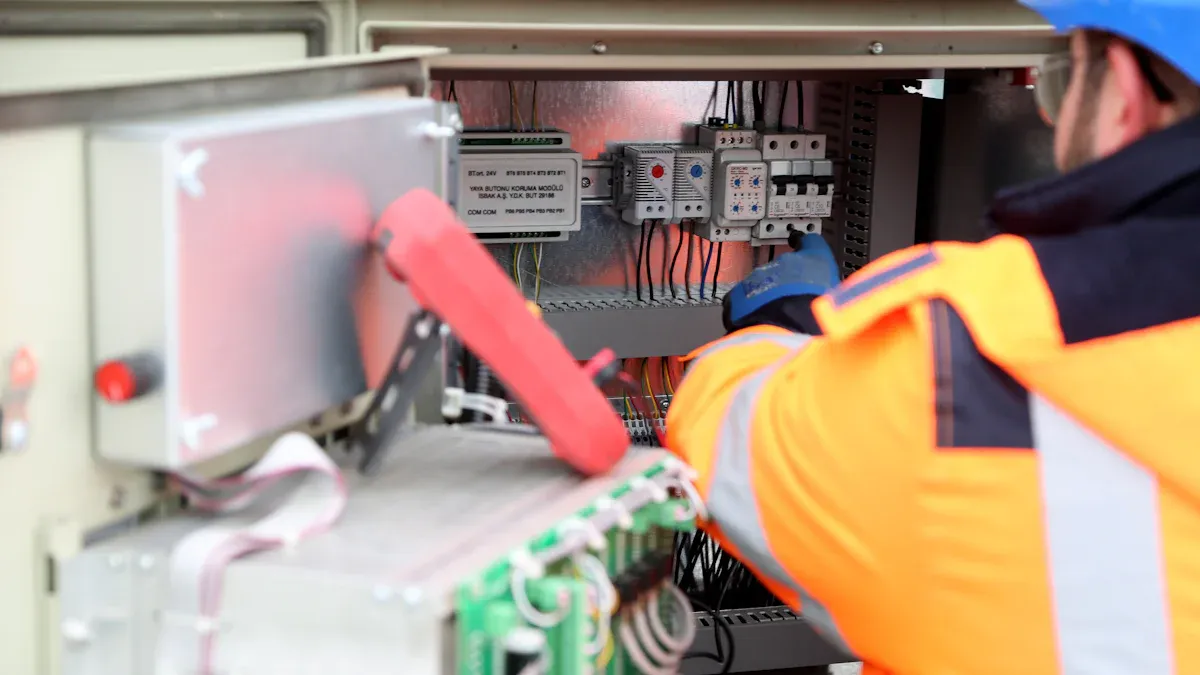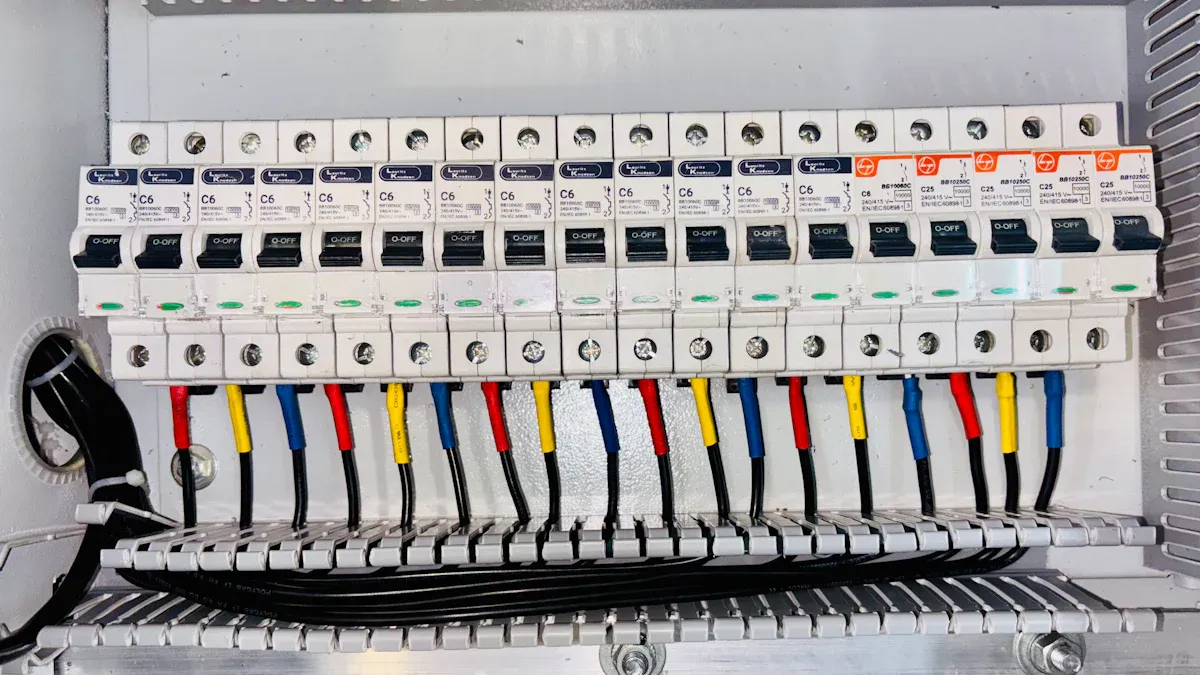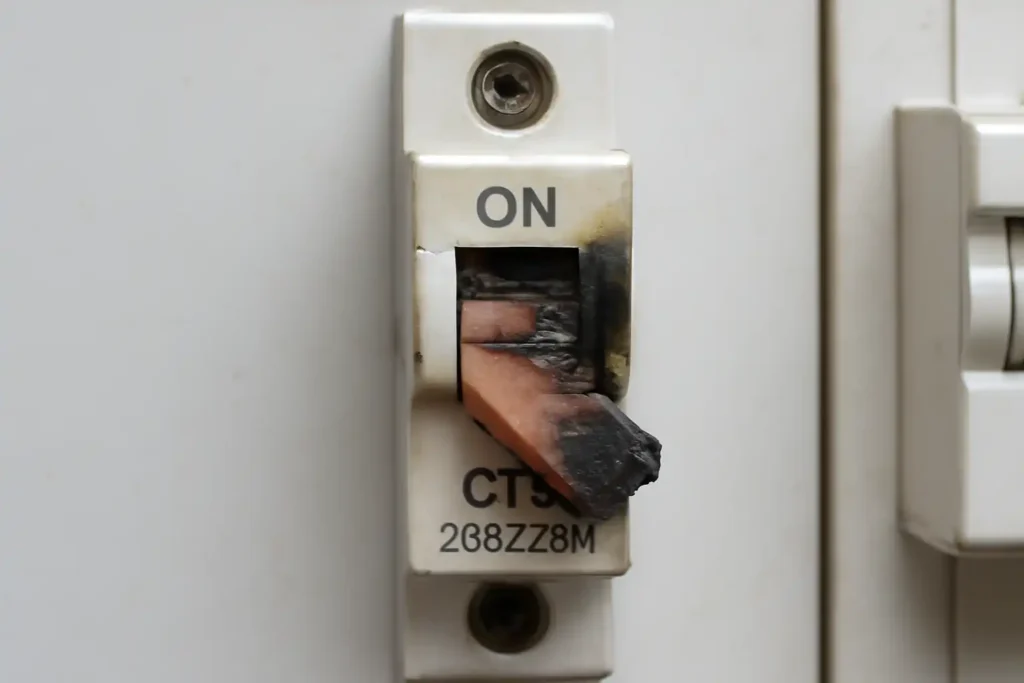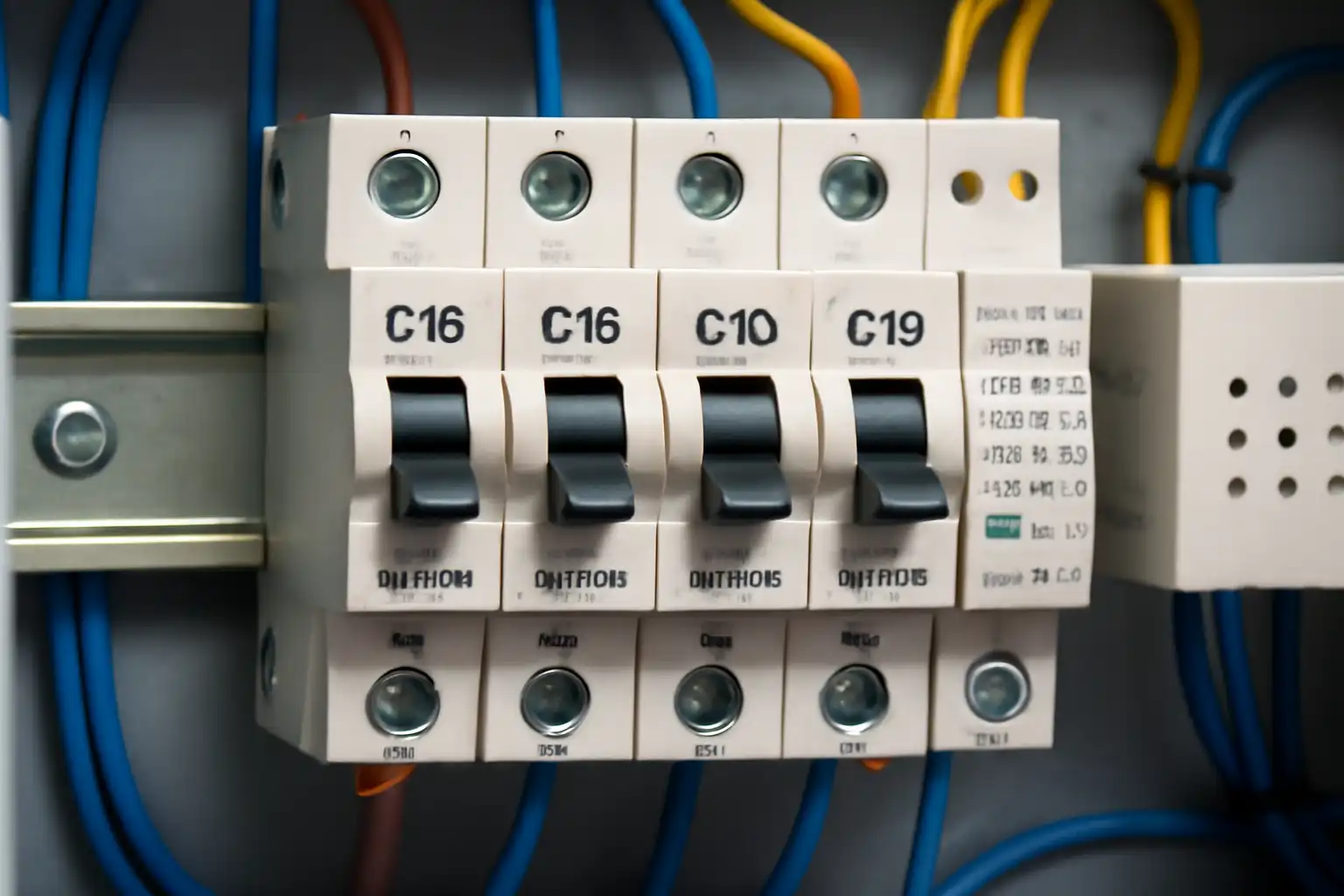A circuit breaker is designed to handle many trips in its lifetime. However, if the circuit breaker tripped too often, it can lead to premature wear. Typically, these devices can last for hundreds to thousands of trips, with most types capable of tripping between 5,000 and 10,000 times, depending on their brand and design. If you notice that your breaker trips frequently, it may indicate an issue within your electrical system. Addressing these problems promptly can prevent damage and extend the lifespan of your breaker.
Key Takeaways
-
Circuit breakers can trip many times, but too many trips might mean problems.
-
Taking care of them and installing them correctly helps them last longer.
-
Things like heat and moisture can make circuit breakers wear out faster.
-
If you see burn marks or hear odd sounds, call an expert right away.
-
Fixing electrical issues quickly can save money and keep your home safe.
What Happens When a Circuit Breaker Trips?

Purpose of a circuit breaker trip
A circuit breaker is an important safety tool in your home. Its job is to stop electricity flow when there’s a problem, like too much power or a short circuit. This helps protect your wires and devices from damage. For example, during an overload, the breaker trips if the current goes 10% over its limit. It waits briefly to tell if it’s a quick surge or a real problem. In short circuits or ground faults, it trips almost instantly at 200% of its limit to stop dangerous electricity flow.
How tripping protects your electrical system
When a circuit breaker trips, it keeps your home safe. It stops electricity to prevent wires from overheating, which could melt insulation. This lowers the chance of fires and keeps your devices safe. For instance, if a short circuit happens, the breaker cuts power before more damage occurs. This system keeps your home’s electricity working safely.
-
Benefits of tripping include:
-
Stopping wires from overheating.
-
Lowering the risk of electrical fires.
-
Protecting devices from power surges.
-
Effects of repeated tripping on the breaker
If a circuit breaker trips too often, it can wear out. Each trip weakens its parts, and it might stop working well. A breaker that trips a lot may not handle power properly. This could mean there’s a bigger problem, like too much load or a bad breaker. Fixing these issues quickly can keep your system working and make your breaker last longer.
Tip: If your breaker trips a lot, call an electrician to find and fix the problem.
How Many Times Can a Circuit Breaker Trip?
Typical lifespan of a circuit breaker
The life of a circuit breaker depends on its quality and use. Most breakers can trip 5 to 20 times before wearing out. High-quality breakers last longer than cheaper ones. Breakers in hot or humid places wear out faster. Proper installation and care help them last longer.
When a breaker trips, its parts feel stress. Over time, this stress makes the breaker weaker. For example, a study showed repeated trips cause failures. The exact number of trips before failure is unclear. But frequent tripping shortens a breaker’s life.
Variations based on type and manufacturer
Not all breakers are the same. Different types and brands handle trips differently. Molded case circuit breakers (MCCBs) handle more current and last longer. Medium voltage breakers can adjust to meet system needs.
A study tested how breakers perform under stress. After testing, contact resistance increased, showing wear. The table below shows how testing affects breakers:
|
Testing Condition |
Contact Resistance (Ω) |
Microstructural Changes |
|---|---|---|
|
Untested |
0.00168 |
Low, even resistance with some surface oxides. |
|
After UL overload/temperature-rise |
0.00302 |
Higher resistance with porous surfaces and more oxides. |
|
After UL endurance testing |
2.13 |
Much higher resistance, erosion, and oxide build-up. |
|
After UL short-circuit testing |
12.88 |
Very high resistance, melting, cracks, and less oxide. |
Brands also affect how many trips a breaker can handle. Premium brands use better materials, so they last longer. Cheaper brands may not handle as many trips.
Why there’s no fixed number for trips
There’s no set number for how often a breaker can trip. This is because breakers are made for different uses. Electronic breakers can be programmed for different settings. MCCBs and medium voltage breakers also adjust to different needs.
Environment and usage also affect a breaker’s life. A breaker in a clean, cool place lasts longer than one in heat or dust. Frequent trips from small overloads cause less damage than trips from short circuits.
In short, how many trips a breaker can handle depends on its type, quality, and conditions. Knowing these factors helps you take care of your breaker and make it last longer.
Factors That Affect a Circuit Breaker’s Lifespan
Quality and type of the circuit breaker
The quality and type of a circuit breaker affect how long it lasts. Strong breakers from trusted brands use tough materials. These materials handle wear and many trips without breaking early. Weak breakers may fail faster, especially with frequent trips or heavy loads.
Different breakers last for different amounts of time. Molded case circuit breakers (MCCBs) handle more power and last longer. Advanced breakers, like programmable ones, have extra features. These features protect your system better. Picking the right breaker type helps it work well and last longer.
Frequency and severity of trips
How often a circuit breaker trips changes its lifespan. Frequent trips stress the breaker’s parts, wearing them out. If trips happen often due to overloads, the breaker may fail sooner. Each trip weakens its mechanical and electrical parts.
The strength of the trip also matters. Small overloads cause less harm than short circuits or ground faults. Strong trips use more power and can damage the breaker’s contacts. Fixing overloads or bad wiring can stop frequent trips. This keeps your breaker working longer and your system safe.
Environmental conditions (e.g., heat, humidity, dust)
Where a circuit breaker is placed affects its life. Heat, moisture, and dirt can make it wear out faster. Hot areas, like near ovens or sunlight, can damage the breaker’s parts. This makes it fail sooner.
Humidity adds water to the breaker, causing rust inside. Rust stops the breaker from working well and can lead to failure. Dust can block the breaker’s parts, making it less reliable. Keeping the breaker in a clean, cool, and dry spot helps it last longer.
Tip: Check your breaker panel for dirt or water often. Clean around the panel to protect the breaker from damage.
Installation and Maintenance Practices
Correct setup and regular care help a circuit breaker last longer. When installed properly and maintained often, it works better and stays reliable for years.
Why Proper Installation Matters
How a circuit breaker is installed affects how well it works. Bad installation can cause loose parts, overheating, or early failure. For instance, if not mounted tightly, vibrations can harm its inside parts over time. Always hire a licensed electrician to install your breaker. They follow safety rules and make sure it fits your system and works safely.
Regular Maintenance Steps
Taking care of your breaker helps find and fix problems early. Each breaker type needs special care to work its best. The table below shows how to maintain different breakers:
|
Circuit Breaker Type |
Maintenance Steps |
|---|---|
|
Air Circuit Breaker (ACB) |
Clean air vents often; check parts like the arc chute for wear. |
|
Vacuum Circuit Breaker (VCB) |
Test vacuum pressure; ensure moving parts work smoothly. |
|
SF6 Circuit Breaker |
Check gas pressure; clean debris; look for leaks. |
|
Oil Circuit Breaker (OCB) |
Replace oil regularly; inspect and clean parts as needed. |
Following these steps lowers the chance of frequent trips and keeps your breaker working well.
Easy Tips to Care for Your Breaker
-
Look Often: Check for wear, like strange smells or discoloration. These may mean overheating or damage.
-
Keep It Clean: Dust can mess up the breaker. Wipe the panel area with a dry cloth sometimes.
-
Test It: Manually trip the breaker now and then. This ensures it works during real problems.
-
Watch the Environment: Don’t place the breaker in hot, wet, or dusty spots. These can wear it out faster.
Tip: Have a professional check your breaker every year. Electricians can find hidden problems and do advanced fixes.
By installing it right and caring for it regularly, you can make your breaker last longer and avoid frequent trips.
Signs of a Damaged Circuit Breaker

Trouble resetting the breaker
If resetting a tripped circuit breaker is hard, there may be a problem. A breaker might not reset due to overloads, short circuits, or damage inside. For example, unplugging devices but still failing to reset could mean a short circuit or broken breaker. If it keeps tripping after resetting, it might be bad wiring or faulty appliances. Fix these issues quickly to avoid more damage.
To check the problem, unplug everything on the circuit. Then, try resetting the breaker. If it trips again, look for short circuits or bad wiring. Regular checks and professional help can catch problems early and keep your breaker safe.
Burn marks or cracks on the breaker
Burns, cracks, or discoloration show a circuit breaker might be damaged. These problems often come from overheating or electricity jumping between parts. Over time, this weakens the breaker and makes it less useful.
Check your breaker panel often for damage you can see. If you find burns or cracks, stop using that circuit and call an electrician. Ignoring these signs can lead to fires or system failures. Keeping your breaker in good shape protects your home and devices.
Breaker trips often without a clear reason
A circuit breaker that trips a lot may be wearing out. Old appliances with bad wiring or electricity leaks can cause frequent trips. Short circuits inside devices can also overload the breaker.
To fix this, check the appliances on the circuit. Look for worn-out wires or damage. If the breaker keeps tripping, call an electrician to check your system. Regular inspections and maintenance can stop these problems and help your breaker last longer.
Tip: Frequent trips often mean hidden electrical issues. Fixing them fast can save your breaker and system from damage.
Strange sounds, like buzzing or humming
Hearing strange sounds, like buzzing or humming, can mean trouble. These noises often show the breaker is not working right. Buzzing might happen if the breaker doesn’t trip during an overload. This can make it overheat, damage the breaker, and cause fire risks.
Humming sounds could mean loose wires or broken parts inside. Damaged parts vibrate when electricity flows, creating these noises. Ignoring these sounds can lead to more trips or a broken breaker.
You can use different ways to find the problem. Each method helps figure out what’s wrong and keeps the breaker safe. The table below shows common ways to check:
|
Diagnostic Method |
Purpose |
|---|---|
|
Visual Inspections |
Spot early problems like burn marks or rust |
|
Thermal Imaging |
Find overheating issues |
|
Electrical Testers |
Check voltage, current, and resistance |
If you hear buzzing or humming, turn off the breaker first. Unplug devices on the circuit to lower the load and stop more harm. Then, look at the breaker for damage, like burns or rust. If the noise doesn’t stop, call an electrician for advanced checks like thermal imaging or testing.
Never ignore strange sounds from your breaker. They often mean hidden problems that can cause trips or damage. Fixing them quickly keeps your system safe and working well.
When to Replace or Get Professional Help
Knowing when to replace a breaker
Replace a circuit breaker if it’s damaged or not working. Look for burn marks, cracks, or discoloration on the panel. Frequent tripping without a clear reason may mean internal damage. Follow these steps to check the breaker:
-
Turn off power and wear safety gear.
-
Open the panel and look for loose wires or damage.
-
Unplug devices and reset the breaker to test it.
-
Use a multimeter to check for bad wiring or short circuits.
-
If it still trips, replace it with the right type.
Make sure the new breaker matches the correct size and rating. If unsure, ask a licensed electrician for help.
Why hiring an electrician is important
Electricians are trained to fix tricky electrical problems safely. They can find hidden issues like short circuits or ground faults. Professionals also follow safety rules and local codes for repairs.
Call an electrician if your breaker trips often, smells burnt, buzzes, or sparks. These signs could mean serious problems needing expert care. Hiring an electrician keeps your home safe and prevents more damage.
Tips to stop future problems
To keep your breaker working well, take care of it. Here are some easy tips:
-
Check wires often for damage or wear.
-
Spread out power use to avoid overloading circuits.
-
Use tools to find which outlets connect to each breaker.
-
Plug big appliances into separate outlets on different breakers.
-
Test breakers sometimes to make sure they work in emergencies.
If problems continue, call an electrician to check your system. They can suggest upgrades or changes to handle your home’s power needs. Regular care and expert checks help avoid trips and costly repairs.
Circuit breakers are made to last, but tripping often can weaken them. If this happens too much, it might cause safety problems or expensive fixes. Always check why the breaker trips often to keep your system safe and make it last longer.
-
Key Takeaways:
-
Frequent trips mean there’s a hidden issue.
-
Broken breakers need fixing right away.
-
Regular care keeps them safe and working well.
-
Note: If you see strange signs like buzzing noises or burn marks, call a licensed electrician. Acting fast protects your home and keeps your electrical system running smoothly.
FAQ
What should you do if your circuit breaker trips often?
If your breaker trips a lot, there’s likely a problem. Unplug everything on the circuit and reset the breaker. If it trips again, the circuit might be overloaded or have bad wiring. Call an electrician to check and fix the issue.
Why does a circuit breaker overheat?
A breaker overheats when it handles too much power. Loose connections can also cause this. Overheating can harm the breaker’s parts. Avoid overloading circuits and tighten loose connections. If it keeps overheating, replace it or call an electrician.
How is a fuse different from a circuit breaker?
A fuse stops power by melting during overloads. A breaker trips instead and can be reset. Breakers are reusable, but fuses need replacing after each use. Breakers are easier and more practical for most homes.
What happens if you don’t fix a damaged circuit breaker?
Not fixing a bad breaker can lead to fires or failures. It might not trip during overloads, causing overheating or short circuits. Replace damaged breakers quickly to keep your home safe.
What tools can you use to test a circuit breaker?
You can use a multimeter to check voltage and resistance. Thermal imaging finds overheating spots. Electrical testers ensure current flows correctly. These tools help find problems before they get worse.
The following information may be of interest to you
What Are the Signs of a Bad Circuit Breaker
How to Maintain Molded Case Circuit Breakers Effectively
Analysis of the cause of air conditioning circuit breaker tripping




